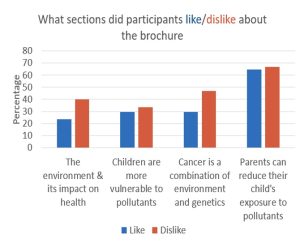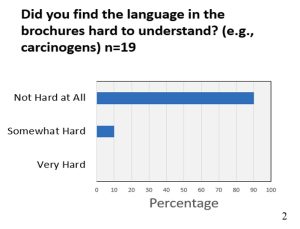School of Medicine
35 Creating and Obtaining Feedback on a Childhood Cancer Environmental Health Brochure: Results from Researcher Survey
Marlon Lopez (University of Utah); Anne Kirchhoff (Pediatrics, University of Utah); Sarah Bayardo (University of Utah); Karely Mann (University of Utah); and Judy Y. Ou (University of Utah)
Faculty Mentor: Anne Kirchhoff (Pediatrics, University of Utah)
Introduction
Approximately 1 in 285 children in the U.S. will be diagnosed with cancer before their 20th birthday1. Many parents and caregivers of children with cancer have little to no knowledge of how the environment could be an attributing factor on the development of cancer2. Our goal is to inform the public about how environmental carcinogens may affect the risk of cancer by creating a brochure on this topic, mentioning carcinogens found in daily life as well as prevention methods for parents and caregivers of childhood cancer survivors. We received feedback on the brochure through an online survey sent to researchers connected to Huntsman Cancer Institute (HCI) with questions that would provide us with quantitative as well as qualitative data.
Methods
We conducted a systematic literature review on environmental carcinogens in research publications such as PubMed and Science direct; in total, 11 papers, relating to environmental carcinogens, were reviewed, and summarized. We then compiled a brochure for caregivers of young cancer survivors that would use concise and lay language. We created and sent out a survey through REDCap to HCI researchers. The survey questions included demographics, comprehensibility, if the information was educational, their preferred section, and how ready the brochure is to be released.
Results: The survey was sent to 26 researchers; 19 had usable survey information. Of these, 76.5% of had more than a 4-year college degree; 73.7% were somewhat to very familiar with the field of environmental health. Around 21.1% said they knew a lot about environmental health. The majority (89.5%) found the language of the brochure “not hard to understand” and 78.9% of participants reported learning something new. Most participants indicated the content on how to reduce exposure as their favorite (64.7%). On a scale from 1-10 for whether the brochure was ready for dissemination (1=not ready; 10=completely ready), the mean was 6.29.


Conclusion
The brochure received positive feedback from participants. Participants expressed mostly favorable opinions on the brochure’s contents. The participants mostly agreed that it does not include difficult language, and that they absorbed new information, exhibiting positive as well as constructive opinions on the various section of the brochure. Limitations in this research included not having the sufficient time to send the survey out to more participants with a more diverse background, in education and knowledge. Receiving feedback from our target audience would be most valuable since it was meant for them. Next steps include getting feedback from parents and caregivers of survivors as well as further peer revisions and edits for future dissemination based on the feedback that we received. Creating approachable ways of communicating scientific information is vital to protecting vulnerable children from environmental carcinogens.
Acknowledgment
This work was supported by the Office of Undergraduate Research’s Summer Program for Undergraduate Research and the National Institute of Environmental Health Sciences award R25ES031497. The content in this presentation is solely the responsibility of the authors and does not necessarily represent the official views of the National Institutes of Health.
References
- US Childhood Cancer Statistics. ACCO. Accessed August 2, 2022. https://www.acco.org/us- childhood-cancer-statistics/
- Vetsch J, Wakefield CE, Doolan EL, et al. “Why us?” Causal attributions of childhood cancer survivors, survivors’ parents and community comparisons – a mixed methods analysis. Acta Oncol. 2019;58(2):209-217. doi:10.1080/0284186X.2018.1532600

